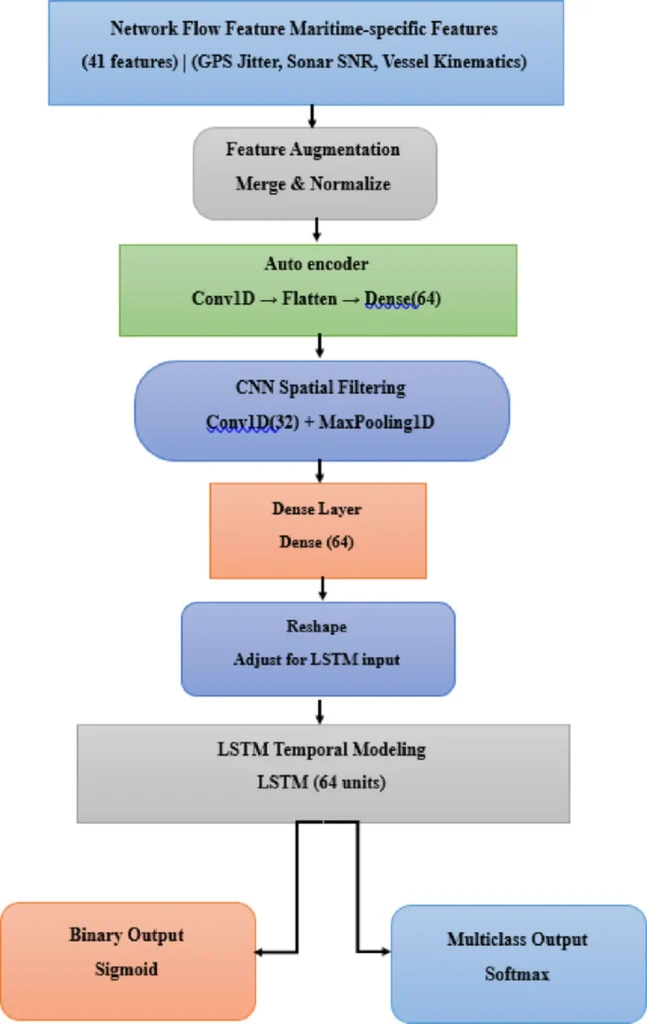In the ever-evolving landscape of maritime operations, the integration of Internet of Things (IoT) devices has brought about significant advancements, but it has also opened the door to new cybersecurity challenges. A recent study published in the journal ‘Scientific Reports’ (translated from the original ‘Nature Scientific Reports’) tackles this issue head-on, presenting a novel approach to smart maritime threat detection. The research, led by R. Anuja from the Department of Computer Science and Engineering (AI & ML) at Rohini College of Engineering and Technology, introduces a hybrid deep learning model that combines Autoencoder (AE), Convolutional Neural Network (CNN), and Long Short-Term Memory (LSTM) networks to bolster cybersecurity in marine environments.
The study addresses the growing cyber risks associated with the proliferation of IoT-enabled sensors, navigation units, and communication links in maritime operations. Anuja and her team developed a framework that unifies unsupervised reconstruction signals with spatio-temporal feature learning for intrusion detection in marine cyber-physical networks. This means the model can learn to recognize normal patterns and detect anomalies in real-time, providing a robust defense mechanism against cyber threats.
The model was trained and evaluated on a benchmark dataset adapted to simulated maritime scenarios, supporting both binary and multiclass classification. In the binary setting, the system achieved an impressive 99.8% accuracy. In the multiclass setting, it demonstrated strong performance across various metrics, including precision, recall, F1-score, and AUC. The study also analyzed minority-class behavior using confusion matrices and threshold sensitivity, providing a comprehensive evaluation of the model’s capabilities.
One of the key advantages of this approach is its ability to provide auxiliary anomaly cues through reconstruction errors, which can aid in the triage of potential threats. This feature is particularly valuable in operational environments where quick and accurate decision-making is crucial.
When compared to representative deep-learning and transformer baselines, the proposed model yielded competitive to superior results while remaining suitable for real-time deployment in smart ports, autonomous vessels, and underwater sensor networks. This makes it a promising solution for enhancing cybersecurity in various maritime sectors.
“The model’s ability to handle both binary and multiclass classification tasks makes it versatile and adaptable to different scenarios,” said Anuja. “Its strong performance across various metrics and its suitability for real-time deployment make it a valuable tool for improving maritime cybersecurity.”
The study also discusses practical constraints, such as dataset realism and class imbalance, to contextualize the model’s applicability in operational environments. This ensures that the findings are not only theoretically sound but also practically relevant.
For maritime professionals, this research opens up new opportunities for enhancing cybersecurity in smart ports, autonomous vessels, and underwater sensor networks. The model’s ability to provide real-time threat detection and its strong performance across various metrics make it a valuable tool for safeguarding maritime operations against cyber threats.
As the maritime industry continues to embrace digital transformation, the need for robust cybersecurity measures becomes increasingly critical. This study represents a significant step forward in addressing this need, providing a powerful tool for protecting maritime assets and ensuring the safety and security of maritime operations.
In the words of Anuja, “The model’s competitive performance and real-time deployment capability make it a promising solution for enhancing cybersecurity in the maritime sector.” This research not only advances the field of maritime cybersecurity but also offers practical solutions that can be implemented to protect maritime assets and operations.

